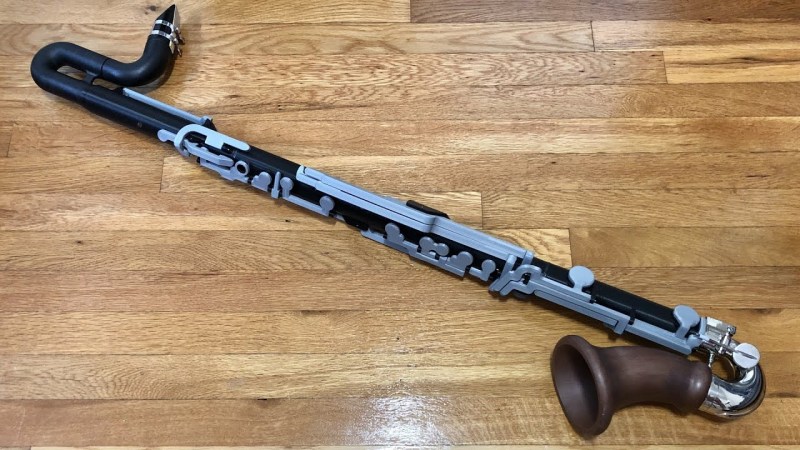Playing music as part of a group typically requires that not only are all of the instruments tuned to each other, but also that the musicians play in a specific key. For some musicians, like pianists and percussionists, this is not terribly difficult as their instruments are easy to play in any key. At the other end of the spectrum would be the diatonic harmonica, which is physically capable of playing in a single key only. Other orchestral instruments, on the other hand, are typically made for a specific key but can transpose into other keys with some effort. But, if you have 3D printed your instrument like this bass clarinet from [Jared], then you can build it to be in whichever key you’d like.
The bass clarinet is typically an instrument that comes in the key of B flat, but [Jered] wanted one that was a minor third lower. Building a traditional clarinet is not exactly the easiest process, so he turned to his 3D printer. In order to get the instrument working with the plastic parts, he had to make a lot of the levers and keys much larger than the metal versions on a standard instrument, and he made a number of design changes to some of the ways the keys are pressed. Most of his changes simply revert back to clarinet designs from the past, and it’s interesting to see how simpler designs from earlier time periods lend themselves to additive manufacturing.
While [Jared] claims that the two instruments have slightly different tones, our amateur ears have a hard time discerning the difference. He does use a standard clarinet bell but other than that it’s impressive how similar the 3D printed version sounds to the genuine article. As to why it’s keyed differently than the standard, [Jared] points out that it’s just interesting to try new things, and his 3D printer lets him do that. We’d be happy to have another instrument in our 3D printed orchestra, too.

















Diatonic harmonicas can in fact be played in many keys through the use of bends and overblows.
https://www.harmonicalessons.com/overview_chart.html
In the same vein, this article presents a 3D printed instruments wiki :
https://hackaday.com/2014/03/29/3d-printed-instrument-roundup/
And this 3D printed trumpet that I found a few days ago even if it doesn’t sound great (it’s not state-of-the-art at all) :
https://www.youtube.com/watch?v=B1j_d2mSGng
So…
nothing about a basswood cabinet?
Or Cabernet for bass?
This is EXACTLY what I want! Rev up that printer
That’s a pretty sophisticated project: respacing all the tone holes to make it play in-tune in G and then reorganizing the lever system to hit them with something close to the same fingerings … and to make it sound good. Great job!
Jared’s work needs to be written about on this site more. He has been a pioneer in the realm of homemade instruments for a long time now, some of his other work is unbelievable. Even some of the projects that he never ended up finishing (or put on hold, like the OctoContraBass Clarinet) still provide a lot for people interested in woodwind repair/creation to learn from. I’ve always thought that 3d printed keywork wouldn’t work well enough to justify the effort involved in designing the parts, then Jared posts this.
Some years ago i taught drafting (SolidWorks) and for a final project one girl modeled her Bb clarinet, screws, pads, rods, et al. Her mother was not happy she disassembled the whole thing to get measurements, but it worked when she was done. Unfortunately, no 3D printers available :(